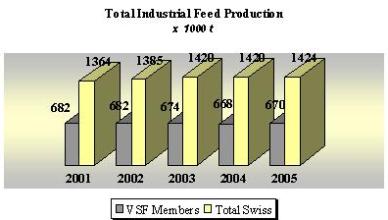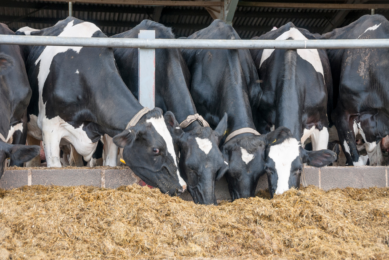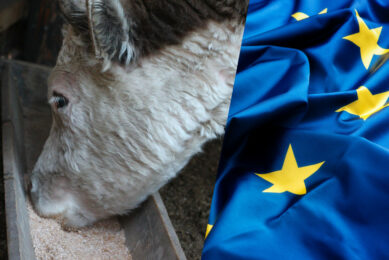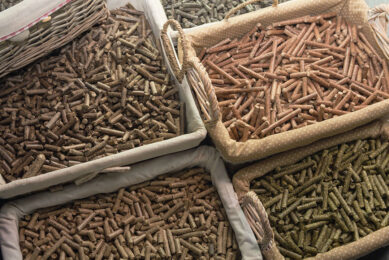Industrial Compound Feed Product

Accurate statistics for Switzerland are not available because the fenaco-group and the small local feed millers do not publish their manufactured feed tonnage. The United Swiss Feed millers (VSF) estimate that in 2005 around 1,424 million tonnes of compound feed were manufactured.
Compound feed production figures in Switzerland are reported by the VSF only.
This organisation represents 70 compound feed manufacturers, which represent 47%
of total feed production. Cooperatives (UFA in the fenaco-group, Haefliger and
local cooperatives) have a 48% share and the remaining 5% is filled in by local
manufacturers.
VSF-members could increase their production with 0.2% compared to 2004. The
manufactured 669,500 tonnes of compound feed, concentrates and premixes.
| |
| Note: Total Swiss figures estimated |
The Swiss dairy market in 2005 showed great turbulence. The oligopoly on the
processing side, the forthcoming abolition of milk quota as well as the complete
liberalisation of the cheese market in 2007 require large efforts on all stages
of the milk market. Despite these facts compound feed production for the dairy
cattle sector could be raised with + 1.3% to 124,000 tonnes. This was remarkable
because through the whole of 2005 abundant roughage was available. Harvest and
pasture were possible to the beginning of winter. The share of compound feed for
dairy increased from 20.3% to 20.5% compared to 2004.
Feed production for beef was also on the increase with 3.6% to 21,000 tonnes.
Consumption of beef developed positively with an increase of 2.1%. The BSE
discussions seem to belong to the past. The collapse of the protein concentrates
for beef cattle (- 42.2%) could not be explained. It might be a statistical
error.
Pig meat production rose considerable with 4,0%, while pork consumption on
improved 2,1% which led to an increase of the self-sufficiency degree with
serious impact on the markets. The fact that under these conditions also an
increase of the pig feed production was registered is no surprise, However, the
upward figure is only 1,2% and does not match with the increase in pork
production. The question remains open, who profited from the extra production.
Pig feed remains the strong pillar in the compound feed industry. The pig feed
production amounted to 198,200 tonnes (+ 1.2%). Total output improved in the
year under report a little over 0.5% to a 42.9% share.
For three years in a row production of poultry feed is declining. In 2004 a
strong reduction was observed (-7.8%) in broiler feed, but in 2005 this downward
trend could be stopped despite bird flu. Layer feed however saw a decrease of
2.7%. Altogether 151,300 tonnes (-1.6%) of poultry feed were manufactured, which
is 2,500 tonnes less than in 2004. Poultry feed sales among VSF members has a
share of 23.2%.
The total Swiss production of milkreplacers suffered a production loss of
10.9% in the year under report in accordance with TSM statistics (of 18,338
tonnes to 16,342 tonnes). Both veal consumption (-2.7%) as well as veal
production (-4.1%) developed declining.
The very high 2005 milk powder prices are further depressing the market and
do not promise any positive perspectives for the future.
In other categories of farm animals the compound feed production declined
too. Feed for rabbits lost 7.3% and horse feed production came down with 5.4%.
There is hardly any commercial rabbit farmer left and the rabbit feed is more
and more bought at the pet food section in the wholesale
department.
Source: Vereinigung Schweizerischer
Futtermittelfabrikanten (VSF) http://www.vsf-mills.ch:80/ (in French and German)











